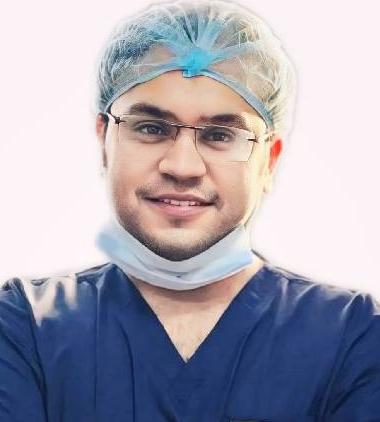Microvascular Decompression Surgery - Procedure, Side Effects

Treatment Duration
45 Minutes
------ To ------60 Minutes
Treatment Cost
₹ 2,50,000
------ To ------₹ 3,00,000

Table of Contents
- Conditions treated with Microvascular Decompression
- Who needs Microvascular Decompression?
- How is Microvascular Decompression performed?
- What Can You Expect Before the Surgery?
- What Can You Expect After the Procedure?
- What are the benefits of Microvascular Decompression
- What are the risks and complications of Microvascular Decompression?
- What the risks of delaying Microvascular Decompression?
- What is the Cost of the procedure?
Loading...
Microvascular Decompression (MVD) surgery is a procedure used to relieve pressure caused by the abnormal compression of the cranial nerve by a vein or artery. The process involves a craniotomy (opening the skull) and inserting a sponge between the cranial nerve and the artery triggering the pain. The surgery is recommended when medications haven’t bought relief.
| Surgery Name | Microvascular Decompression |
| Procedure Name | Jannetta procedure |
| Conditions Treated | Trigeminal Neuralgia, Hemifacial spasm, Glossopharyngeal neuralgia |
| Benefits of the Surgery | Quick ease in pain, Long-lasting relief of the symptoms i.e. pain and muscle twitching, Relatively safe procedure with a low risk of blood loss or infections, Low risk of facial pain or spasm recurrence |
| Treated By | Neurosurgeon |
You can check Microvascular Decompression Surgery Cost here.
Conditions treated with Microvascular Decompression
Microvascular decompression is often used to treat:
- Trigeminal Neuralgia (a condition that causes painful sensation like an electric shock on one side of the face)
- Hemifacial Spasm (a nervous system disorder that involves the involuntary twitching of the muscles on one side of your face)
- Glossopharyngeal Neuralgia (a rare condition characterised by repeated episodes of severe pain throat, ear, tongue, and tonsils)
Expert Doctors (10)
NABH Accredited Hospitals (10)


Who needs Microvascular Decompression?
You may be a candidate for microvascular decompression if:
The procedure involves the use of general anaesthesia and brain surgery. Therefore, patients with other medical conditions may not be candidates for microvascular decompression surgery. It is not a successful treatment for facial pain caused by multiple sclerosis.
- You have trigeminal neuralgia that did not get better with medications.
- You want minimal to no facial numbness associated with other treatments, such as glycerol injection or percutaneous stereotactic radiofrequency rhizotomy (PSR).
- You have facial pain in the ophthalmic division or all three trigeminal divisions.
- You experience a recurrence of facial pain after a previous PSR or radiosurgery procedure.
The procedure involves the use of general anaesthesia and brain surgery. Therefore, patients with other medical conditions may not be candidates for microvascular decompression surgery. It is not a successful treatment for facial pain caused by multiple sclerosis.
How is Microvascular Decompression performed?
The steps involved in the procedure include:
- Step 1: Preparing the patient
In the OT room, the anaesthesiologist will administer general anaesthesia. Once you are asleep, the team will roll you to your side and place your head in a 3-pin skull fixation device. The device attaches to the table and holds your head in place. - Step 2: Performing a craniotomy
The surgeon will make a 3-inch curved incision behind your ear. He/she will lift the muscles off the bone and fold them back. Next, he/she will use a drill to make a 1-inch opening in the occipital bone. The bone will be removed to expose the brain’s protective covering called the dura. The surgeon will use surgical scissors to open and fold back the dura, exposing the brain. - Step 3: Exposing the nerve
The surgeon will place retractors on the brain and use the operative microscope to identify the trigeminal nerve at its origin with the brain stem. Next, they will identify any offending blood vessel exerting pressure on the nerve. The blood vessel will be gently separated from the nerve using scissors and a knife to dissect the thickened connective tissue. - Step 4: Inserting a Teflon sponge
Your surgeon will cut a piece of Teflon sponge and insert it between the nerve and the blood vessel to prevent any further nerve compression. - Step 5: Closing the craniotomy
Once the sponge is in its place, the surgeon will remove the retractor from the brain. He/she will close the dura with sutures. Next, he/she will place a titanium plate to cover the skull opening and secure it with tiny screws. The muscles and skin will be sutured back together, and a dressing will be placed over the incision.
What Can You Expect Before the Surgery?
- The doctor will advise you for a pre-anaesthetic checkup.
- They will ask you about your medical history and the medications, herbs, and supplements you are taking.
- At least one week before the surgery, you may need to stop taking blood thinners and non-steroidal anti-inflammatory medications.
- The doctor will perform presurgical tests, including chest X-ray, electrocardiogram, audiogram, and blood tests several days before the surgery to check if you are fit for the procedure.
- They may ask you to wash your skin and hair with an antiseptic shampoo before the surgery to reduce the risk of surgical site infections.
- Your healthcare team will inform you to stop eating or drinking anything after midnight the night before the procedure.
- You can take permitted medications with a small sip of water.
- Avoid dental treatments within three weeks and any other surgery within three months of the planned procedure.
- The doctor will explain the procedure, the benefits and risks, the estimated cost, and the insurance formalities.
What Can You Expect on the Day of the Surgery?
- The hospital team will ask you to sign consent formalities, giving your permission for the procedure.
- The nursing team will inform you about the change of clothes and removal of jewellery and dentures.
- A nurse will ask you questions about your name, date of birth, the name of the procedure, and the side of your facial pain.
- Someone will shave the excess hair at the surgical site.
- Your doctor will record your last meal and may give you a medicine to be taken with a sip of water.
- The anaesthesiologist will monitor your vitals, including heart rate, blood pressure, and breathing.
- The team will shift you to the OT room.
What Can You Expect During the Surgery?
- In the OT room, you will lie on the operating table.
- The team will start an IV line for fluids and medications in your arms and hands.
- The anaesthesiologist will administer general anaesthesia to make you sleep during the procedure.
- Once you are asleep, you will be rolled to your side.
- The doctor will attach your head to the operating table with a 3-pin skull fixation device.
- The medical team will clean the surgical area with an antiseptic solution.
- The anaesthesiologist will monitor your vitals throughout the procedure.
- The surgeon will make an incision behind your ear and perform the procedure.
- Once the procedure is completed, he/she will close your skin with sutures and place a sterile bandage over the wound.
- The complete procedure generally takes around 2 to 3 hours.
What Can You Expect After the Procedure?
In the hospital
- After surgery, the team will shift you to the recovery room, where the anaesthesiologist will monitor your vitals and the effect of anaesthesia.
- Once you are awake from anaesthesia, the team will shift you to an Intensive Care Unit (ICU) for close observation.
- You might experience a headache and some nausea after the surgery. The doctor will give you medication to manage these symptoms.
- Once your condition stabilises, the team will move you to a regular room.
- Your activity will gradually increase, such as getting out of bed, sitting in a chair, and walking.
- You will be discharged from the hospital within 1 to 2 days after the procedure.
- Your doctor will provide home care and follow-up instructions.
At Home
Incision Care- Avoid showering and using shampoo for 3 to 4 days after the surgery.
- Do not apply any lotion to the incision.
- You cannot use hair dye or other harsh products for six weeks.
- Light physical activity, like a walk for 5 to 10 minutes every 3 to 4 hours, is fine.
- Sleep with your head elevated.
- Apply ice 3 to 4 times per day to reduce swelling and pain.
- Avoid sitting for long periods.
- Avoid engaging in strenuous activities and lifting objects heavier than 2 kg.
- Avoid drinking alcohol - it can increase the chances of bleeding.
- Avoid smoking, as it may delay healing.
- Do not drive or resume work until your surgeon says otherwise.
Medications
- If you have been taking medications for trigeminal neuralgia before the procedure, you will be able to gradually reduce the medication over several weeks after the procedure.
- Do not take NSAIDs, blood thinners, and supplements without your doctor’s approval.
- If you experience pain, take pain medications as directed by the doctor.
- You may experience swelling of the ear and face, taking several weeks to subside.
First Follow-Up Appointment
- Your doctor will schedule the first follow-up appointment 10-14 days after the surgery.
- During this visit, the doctor will remove the staples/sutures.
- They will monitor your symptoms, inspect the surgical site, and provide further follow-up instructions. Furthermore, you can discuss resuming work with your doctor.
What are the benefits of Microvascular Decompression
There are several benefits of microvascular decompression for facial pain, which include:
- Quick ease in pain
- Long-lasting relief of the symptoms i.e. pain and muscle twitching
- Relatively safe procedure with low risk of blood loss or infections
- Low risk of facial pain or spasm recurrence
What are the risks and complications of Microvascular Decompression?
Like any other surgery, MVD carries the general side effects of surgeries, including:
- Infection
- Bleeding
- Reaction to anaesthesia
- Formation of blood clots in the legs.
- Facial numbness
- Facial droop
- Hearing loss
- Double vision
- Paralysis of facial muscles
- Difficulty in eye closure
- Hoarseness
- Dysphagia (difficulty in swallowing)
- Unsteady gait
- Seizures
- Brain swelling
- Leakage of cerebrospinal fluid
- Although MVD is a safe procedure, these risks, such as blood clots, can cause some life-threatening complications like cerebellar infarction (stroke).
When to Consult a Doctor?
Call your healthcare professional if you experience:- High fever
- Signs of infection in the incision (redness, pain, swelling, coloured drainage)
- Increased drowsiness, lack of alertness, and unsteady feet
- Weakness in arms or legs, vomiting, and headache
- Severe neck pain (preventing you from lowering your chin to the chest)
- Worsening vision, speech, or confusion
- Cerebrospinal fluid leak through the wound, ear, or nose
- Tenderness in the calf of one leg
- Seizure
What the risks of delaying Microvascular Decompression?
If the microvascular decompression surgery is delayed and trigeminal neuralgia goes untreated, the pain can become incapacitating and excruciating. A delay in MVD can profoundly affect your quality of life.
What is the Cost of the procedure?
The cost of arthroscopy ranges from ₹2,50,000 to ₹3,00,000. The cost varies based on the following factors:
- Type of Microvascular Decompression Surgery
- Age of the patient
- The medical condition of the patient
- The type of hospital facility availed - individual room or shared.
| Procedure Name | Cost Value |
| Microvascular Decompression | ₹2,50,000 to ₹3,00,000 |
Last Updated on: 9 November 2022
Disclaimer: The information provided here is for educational and learning purposes only. It doesn't cover every medical condition and might not be relevant to your personal situation. This information isn't medical advice, isn't meant for diagnosing any condition, and shouldn't replace talking to a certified medical or healthcare professional.
Author
HexaHealth Care Team
HexaHealth Care Team brings you medical content covering many important conditions, procedures falling under different medical specialities. The content published is thoroughly reviewed by our panel of qualified doctors for its accuracy and relevance.
Loading...






















